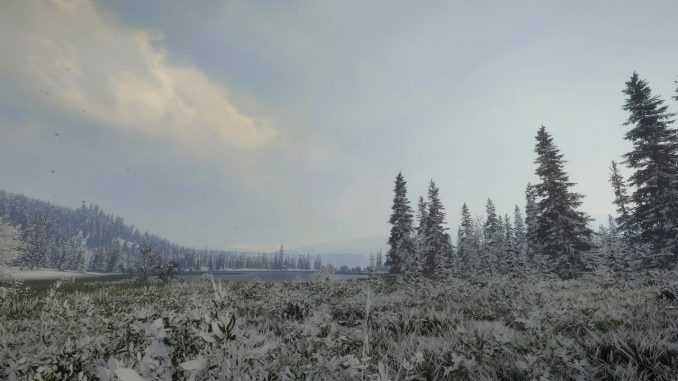
Acknowledgements
I would like to introduce you all to one of the coolest guys on the internet, the prestigious mr. @TommyLght
I’m not lying when I say I couldn’t have written this guide without him. Hold on. The story is good.
I’ve been playing Call of the Wild on Xbox for a while, and was unable to write a guide because the guide section is reserved for people who bought the game on Steam. I tried to contact steam support about the matter, but they were, …less than helpful.
Then, out of nowhere, TommyLght appeared and literally just gifted me the PC version of the game (+a bunch of DLC!!!), just so I could write this very guide (well, and also play the game properly, off-course).
Can you believethis guy? I’ve never met him before. We live ontwo different continents. There is an ocean between me and this guy. And he just shells out his personal hard earned money to give me this game, in the middle of a worldwide pandemic no less.
What a legend.
I would also like to thank mr. @LokkNar, for his inspirational work studying the bullet drop of projectiles in Call of the Wild. Check out his guide too.
Chapter One: Range estimation with your Mil-dot scope
Introduction
You might have noticed that the reticles on the Argus and Hyperion riflescopes in CotW have dots along the lines.
These dots are inspired by a real life system designed for range estimation. They’re called mil-dots.
I’ve done some testing and found that the Hyperion scope can actually be used in the traditional way to estimate range.
I highly recommend using theHyperion 8x scopewhen starting out. The Argus 16x can be used, but it is more inconvenient due to a mistake made by the developers. More on this later.
Disclaimers: I have found the FOV of the aimed scope to be unaffected by the FOV setting in the options, but if the game on your platform has settings to modify aimed FOV, then be aware that this will affect range estimation.
Similarly, there is a perk in the rifles category that makes you zoom in more when holding your breath. I don’t use that but if it affects scopes then it will also affect range estimation and holdover.
Also keep in mind the scope has to be at 8x for this to work, because the reticle doesn’t adjust to the zoom. It is a so-called second focal plane reticle.
What is a Mil?
A MIL is a measurement of angles, similar to degrees, but has a different value. The NATO MIL is inspired by the mathematical milli-radian (One thousandth of a radian), but don’t worry about what that means right now.
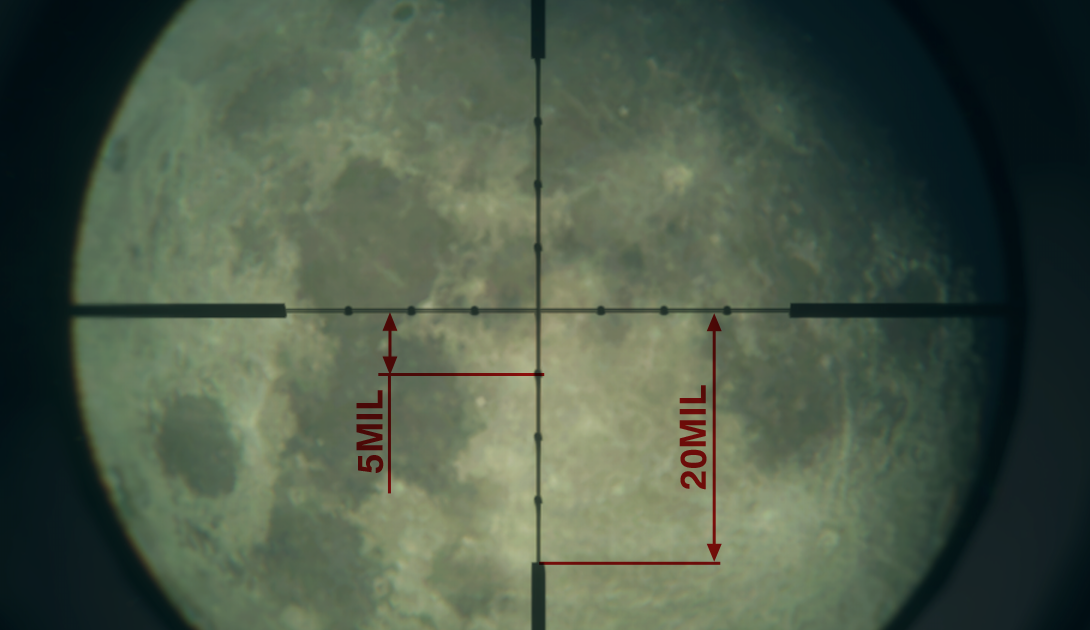
We can use these angular measurements to estimate range because one MIL is the sharp angle in a triangle where the sides are 1000 meters and 1 meter.
thus: (target size [m] * 1000) / MILs = Distance [m] This is the whole formula and that’s basically all you need to know.
Example 1:
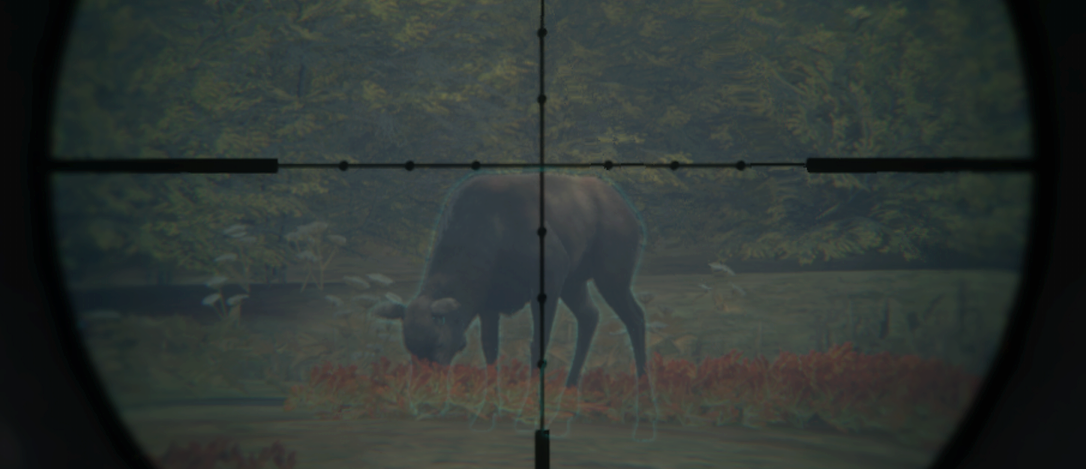
In this picture, you can see that the moose cow is very close and covers about 4 gaps in the scope. For simplicity we will assume the shoulder height of the moose to be 2000mm.
4 gaps = 5 * 4 = 20 MIL.
Distance = 2000mm / 20MIL = 100m.
Range estimation is usually not necessary at this distance, but I show it for teaching purposes.
Example 2:
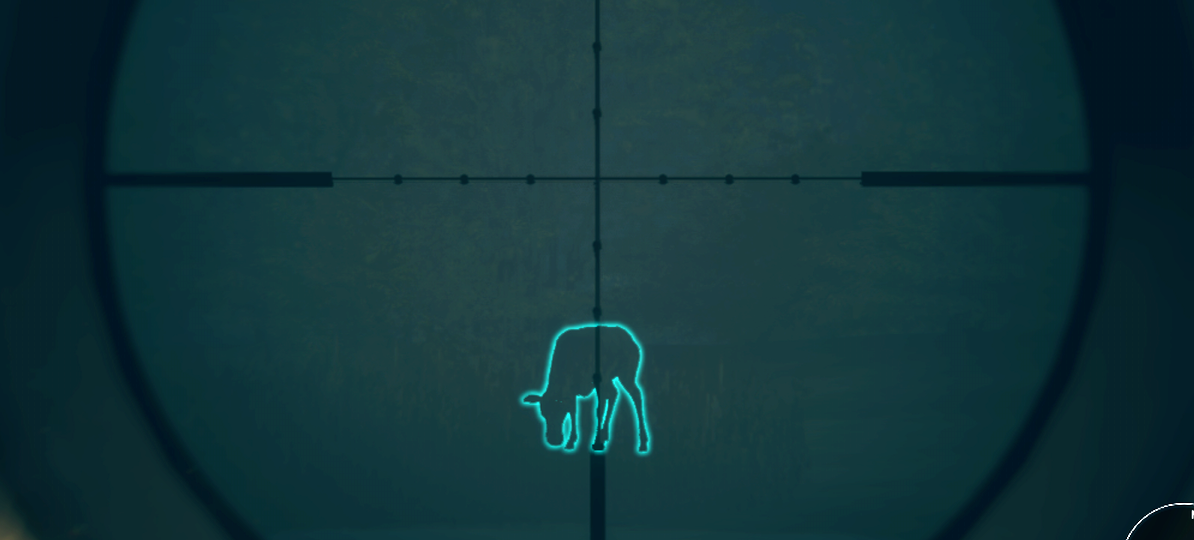
Lets look at the same animal from a bit further away. In this case the shoulder height of the moose covers about two gaps.
2 gaps = 10 MIL
Distance = 2000mm / 10MIL = 200m
Example 3:
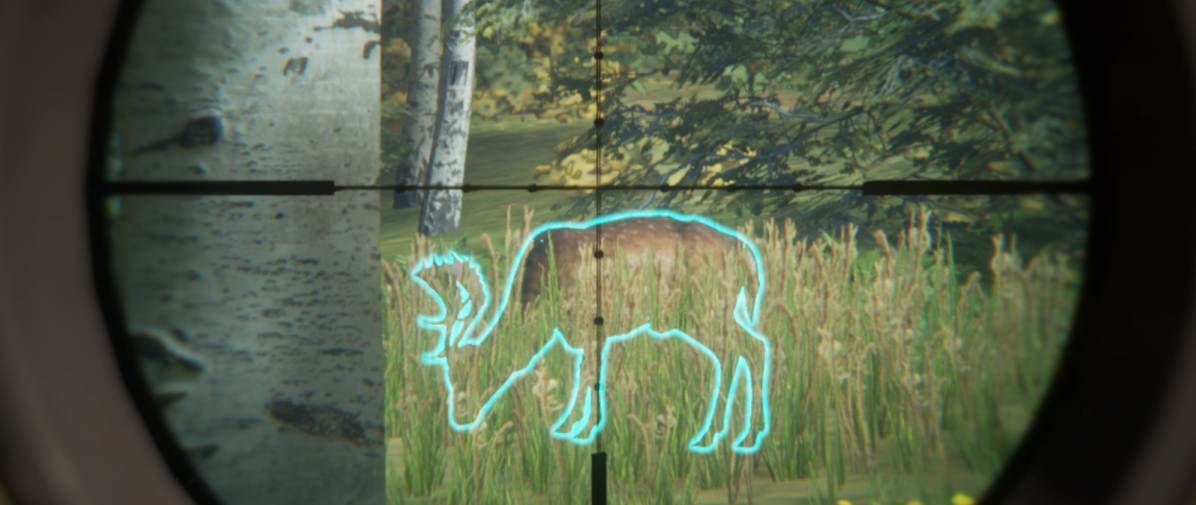
Notice how I use the spotting outline to cut through the foliage. You can use this to your advantage when estimating range. Bucks tend to be less predictable in size, so I tend to measure the does when I can. Lets assume this fallow buck has a shoulder height of about 1000mm.
3,2 gaps = 3,2 * 5 = 16MIL
Distance = 1000mm / 16MIL = 62,5 meters.
Again, at this range you don’t really need a distance estimate to shoot the animal (unless you are using a bow). But range estimation becomes more important at longer ranges.
Why not just use rangefinder or ranger perk?
Good question but nobody is forcing you to use this method. Honestly I don’t know if this form of range estimation is worth the effort in the game because game worlds are scaled a bit differently than the real world and the animal sizes are unknown.This is more for the marksmanship enthusiasts and people who want more immersion in the game. Plus it’s a nice skill to have.
I’ll add it is good to understand MILs and/or MOA if you want to use a scope in real life as thats usually what the actual adjustments are in.
Another thing is that you can use this to measure your bullet-drop in game to create a “Dope-Sheet” for better long range shooting.
Chapter Two: Scope considerations
Why is the Argus scope not good for range estimation?
I told you in chapter one that I do not recommend the Argus 16x scope when starting out with range estimation. I’d like to explain why, and how to circumvent the problem.
As mentioned, the dots in the Hyperion scope are 5 mils apart when the scope is at 8x. This makes it relatively simple to do the mental arithmetic to estimate range. Now, with the Argus having twice the magnification, it would make sense for the reticle to have 2,5 mils between each dot. But its not.
Probably due to a mistake made by the creators of this videogame, the reticle in the Argus scope is scaled incorrectly. As a result, there is approximately 2,38 mils between dots. As you can imagine, dividing something by 2,38 in your head is a huge pain in the posterior orifice.
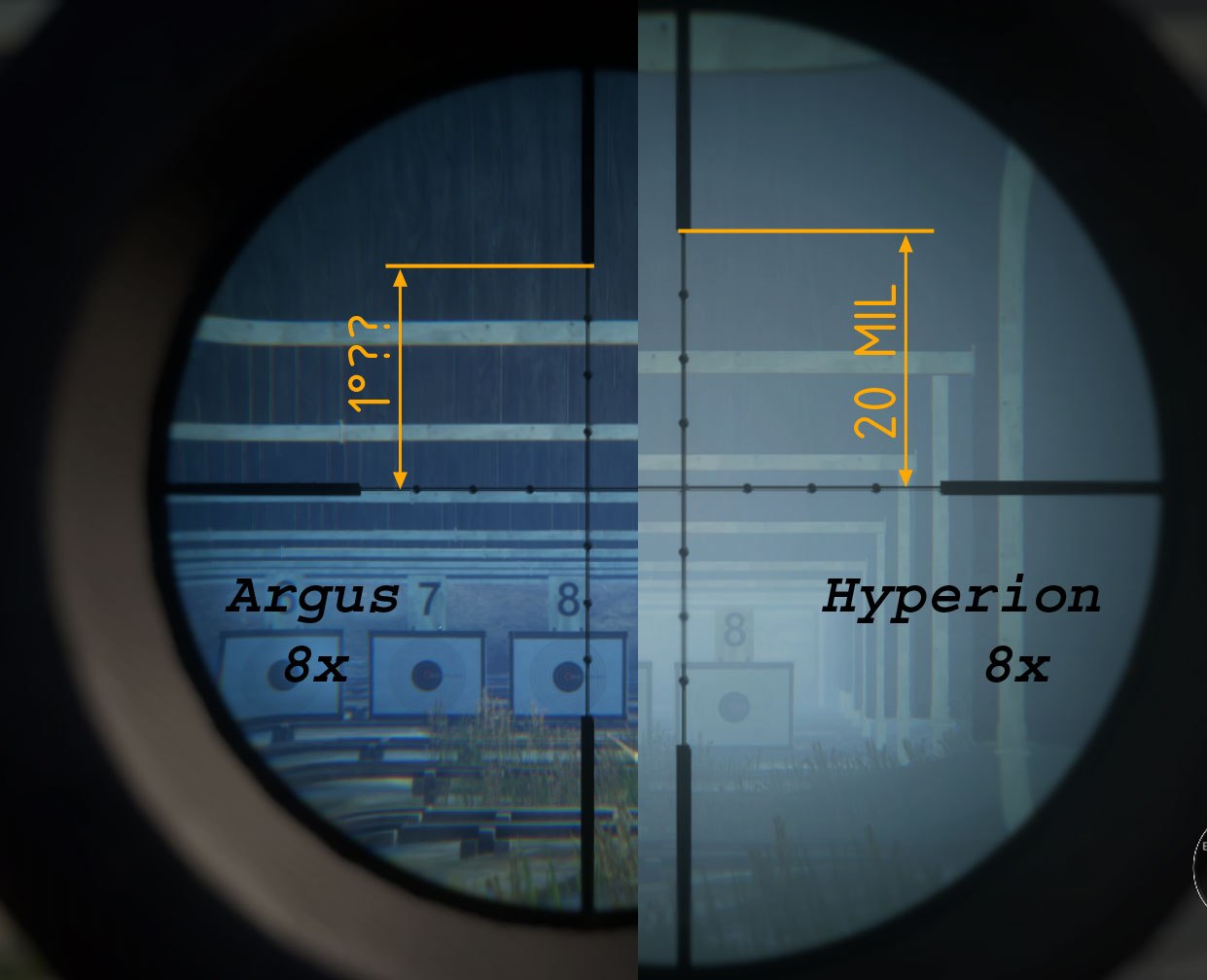
This image shows a comparison of the Argus and Hyperion, both at 8x, to remind you they are not the same.
However, if you are using a calculator anyway, you can just divide by 2,38 instead of 5 if you choose to estimate range with the Argus.
The advantage of using the Argus scope is obviously the increased zoom, but also increased accuracy in mil-readings. The mil reading is a crucial part of the equation to get a good range estimate. Good magnification also helps to provide the correct holdover in long distance shots.
So, range estimation with Argus scope at 16x goes like this:
Range[m] = Target size[mm] / (2,38 * Gaps)
Remember to keep the sight at 16x (fully zoomed in).
What to do if the metric system doesn’t agree with you
Ok. So you hate the metric system and you want to use the English Empire units instead. I get it, and I’ve got some good news for you; You can!
The cool thing about the mils is that it is universal as long as you use the same measurement consistently. If you want to use yards you can, but you have to multiply by a thousand because of the trigonometry. Don’t worry about the trigonometry. Just use this:
Range[yards] = (Target size[yards] * 1000) / (5 * Gaps)
Now, the disadvantage with this is that a lot of people actually prefer to measure target sizes in inches or even feet. If you like to think of your target sizes in inches then I believe MOA (minute of arc) measurements may be more useful than MIL-readings. The dot gap in the Argus scope is 2,38mil. This is roughly equal to 8 MOA, and you can try to think of it as that. None of this is an exact science anyway. You might be able to use this formula:
(Known target size in inches * 95.5) / (Gaps * 8) = Distance in yards.*
*I have not tested the above formula with use of the Argus 16x scope, because I actually prefer metric units.
Chapter Three: Example exercises for range estimation

1. You see a cow moose and a bull moose on the other side of a small lake. You observe the animal through your scope and see that the shoulder height of the cow moose fits perfectly between two dots in the scope. How far away are the animals from you?
The gap between two dots is equal to 5 mils. The animal is 5 mils in the scope. We measure the female, because the females vary less in size. The shoulder height should be 1900 to 2000 millimeters. Lets say 1950mm.
Distance = Target/mils
= 1950/5 = 390 meters
2. Your friend, Swedish Lars, is standing in a treestand on the other side of the valley. He is out of ammo and is surrounded by hungry grizzly bears. One of the bears is a melanistic that you want in your lodge. You can’t get a reading on the bear, because it is moving, but Lars is about 1 + 1/4 gaps tall in the scope. How far away is Lars and the bears?
Lars measures 1,25 gaps = 1,25*5 mil. Hunters are 1,80 meters tall = 1800mm.
Distance = 1800mm / (1,25*5)mil = 288m
3. You find yourself in Silver Ridge Peaks and you have a pronghorn doe in your sights. The shoulder height is 850mm. The animal measures half a gap in the scope. How far away is it?
Distance = 850mm / 2,5mil = 340m
4. Your friend, Texas Bill, is in New Zealand to hunt Fallow Deer. He has spotted a flock of fallows and measures a female in the scope to be about 0,5 gaps tall (shoulder height). Can you help Bill figure out how far away this group of animals is? Keep in mind that Bill prefers english empire units (not metric).
A female fallow should have a shoulder height of about 31.5 inch = 0,875 yards
Distance = (1000*0,875) / (0,5*5) = 350 yards
5. You’re standing on top of a tall, steep hill, looking down at a monster red deer buck. The buck measures 1,33 gaps wide in the scope. What is the distance?
We measure the length of the broadside of the animal, from chest to tail, because the shoulder height is distorted when looking down at him. Such a buck should be about 2500 mm long in this direction.
Distance = 2500mm / (5 * 1,33)mil = 376 meters.
6. Biologist David has arrived in a new hunting reserve, and does not know the shoulder height of the deer species he has found. But he measures the distance to the animal using a laser rangefinder to be about 250m. In the scope, the shoulder height is about 0,8 gaps. What is the actual shoulder height?
We can flip the original formula to yield this: Distance[m] * mil = target size [mm]. You can also use this to calculate bullet drop.
The shoulder height of this type/age of deer is 250 * 0,8 * 5 = 1000mm = 1m (approximately).
7. USING THE ARGUS 16x SCOPE, you measure a pronghorn doe shoulder height at about 0,9 gaps. The shoulder height is 850mm. What is the distance?
Distance = 850mm / (0,9 * 2,38)mil = 397m.
Chapter Four: creating a dope sheet and estimating bullet drop
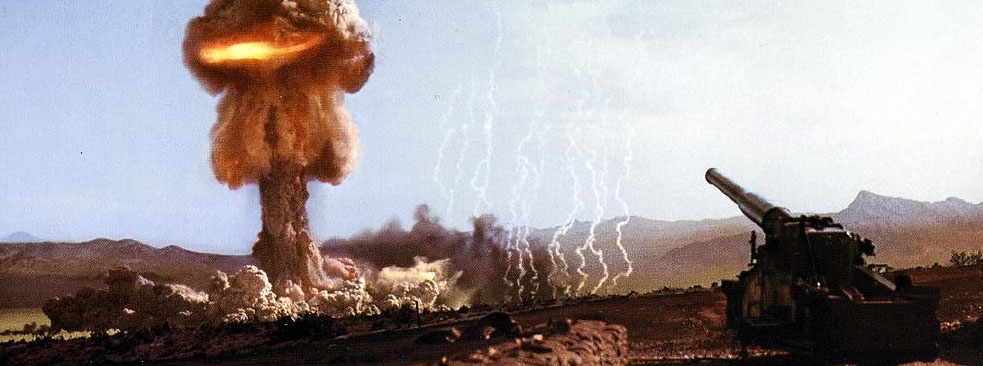
Introduction
The otherthing the dots are useful for, is to use them to determine the holdover necessary to hit a target at long range.
As you probably know, holdover is how much you have to raise the reticle above your intended target to compensate for bullet-drop.
In real life, it may be preferable to adjust the scope to the desired distance, avoiding holdover entirely. But in Call of the Wild there are only three zeroing steps, which makes holdover a necessity at longer ranges anyway. Using the zeroing perk is a matter of preference.
I prefer not to use the zeroing perk, because I often need the windage or other perks. For this reason, my bullet drop and holdover graphs are for rifles zeroed at the medium setting (usually 150m).
How to measure bullet drop
When switching between firearms, it is a good idea to have some form of record of the ballistic trajectory of the given caliber, in order to know your holdover. I like to record how many dot-gaps of holdover are necessary at applicable ranges. I’ll show you graphs for some common rifles but I first want to teach you how to create your own graphs.
Recording the data in the name of science
The first thing to do is travel to Hirshfelden shooting range. Remember when I told you not to use the Argus scope? that was for range estimation. Grab an Argus scope from the locker and put it on the gun you want to test.
At each distance setting you get about ten good hits and record the average drop in how many stripes on the target it drops. Keep the data (write down the numbers).
For the close range targets, I usually aim at the little white stripe between the black and red at the center.

For longer range targets, aim at the top center of the target, just where the paper meets the wood frame. This effectively doubles the deflection range of the reading (with some inconsistency at 20 stripes).
You can stop at 450 meters because, as far as I know, animals will not be drawn past this range.
Converting this useless data into useful information.
Once you have the average amount of stripes the bullet drops at ranges 50 to 450, you multiply the stripe amount with 75 to get drop in millimeters.
I base that on the theory that the target faces are 1,5meters tall (estimated size with reticle). So, if a bullet drops 7 stripes at a given distance then thats 7*75 = 525mm.
Furthermore, to convert these values into holdover, you can use this formula:
Holdover [scope dot gaps] = Drop[mm] / (Range[m] * A)
For Hyperion @ 8x, A = 5 [mil/dot]
For Argus @ 16x, A = 2.38 [mil/dot]
Keep in mind the Argus at 8x does not equal the Hyperion at 8x, because the reticle is distorted.
Example: 525mm drop at 350m distance
Holdover = 525mm / (350m * 5mil/dot) = 0.3 gaps of holdover for the Hyperion at 8x
Holdover = 525mm / (350m * 2,38mil/dot) = 0.6 gaps of holdover for the Argus at 16x
And now you have holdover values, measured in dot-gaps for all the ranges 0 to 450 meters. What I suggest you do with this, is to put it in a spreadsheet and plot a graph. That way you get to see what holdover is necessary between these distances, for example between 350m and 400m.
You can also easily convert the values to English empire units (Yards), if you prefer that.
Some holdover graphs
I know that most people don’t have the time to do this kind of stuff so I’ve gone ahead and made some ready made holdover graphs for you. You can use these to estimate how far above the animal you have to aim, in order for the bullet to hit the animal at a given distance. White background so you can print it out.
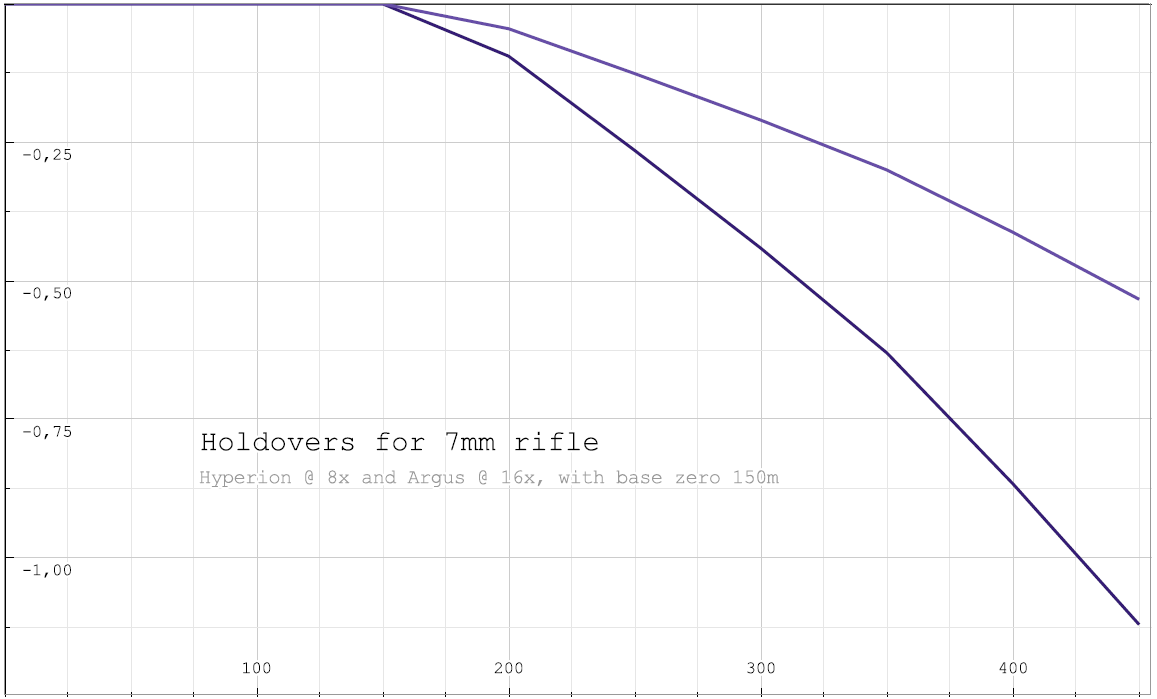
This graph shows the holdovers for the 7mm break-barrel rifle. Class 4-9. The steep curve is the Argus scope at 16x, the other is the Hyperion at 8x. The x-axis is distance in meters. The y-axis is dot gaps between of holdover.
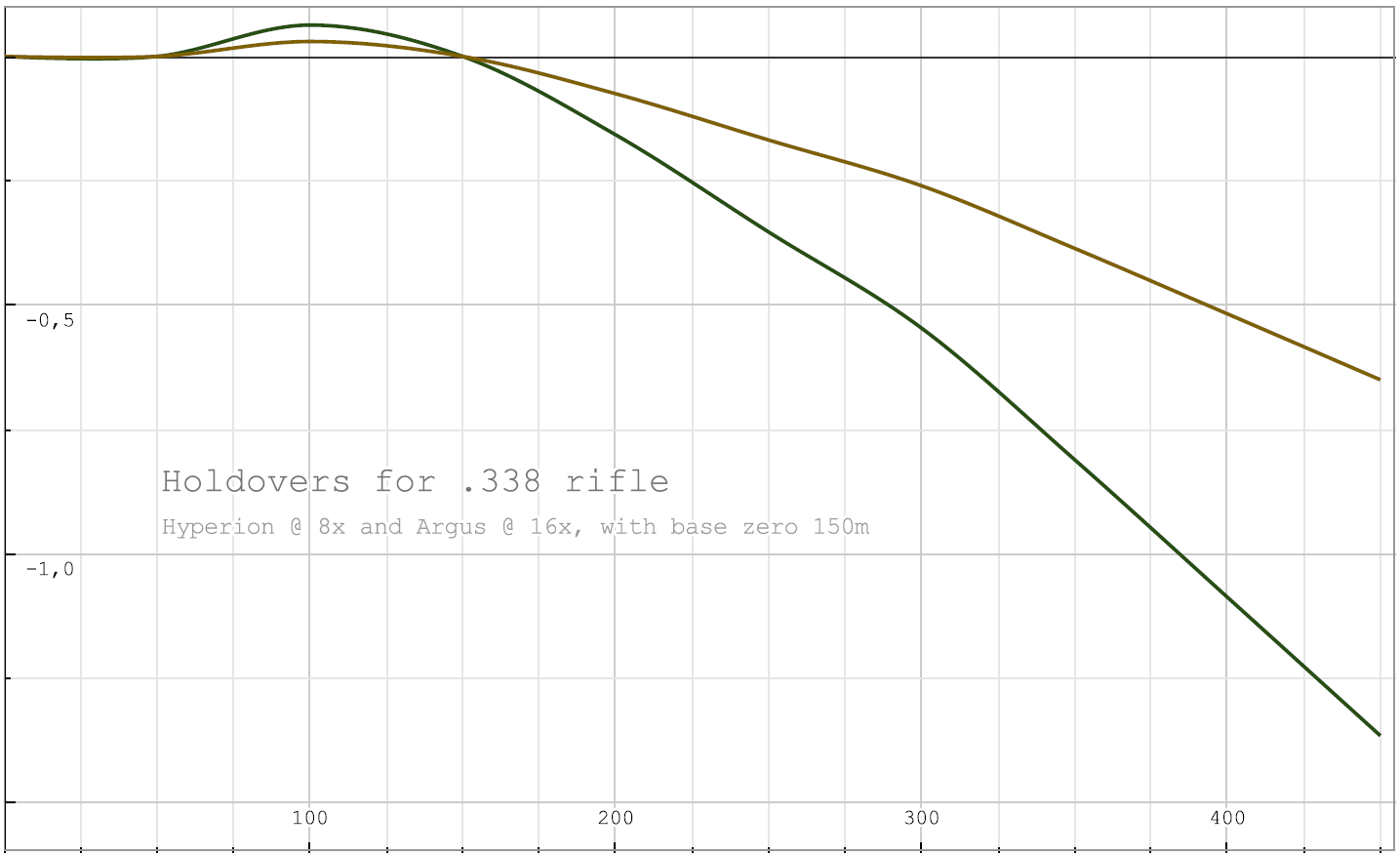
Holdovers for the .338 rifle. Class 7-9.
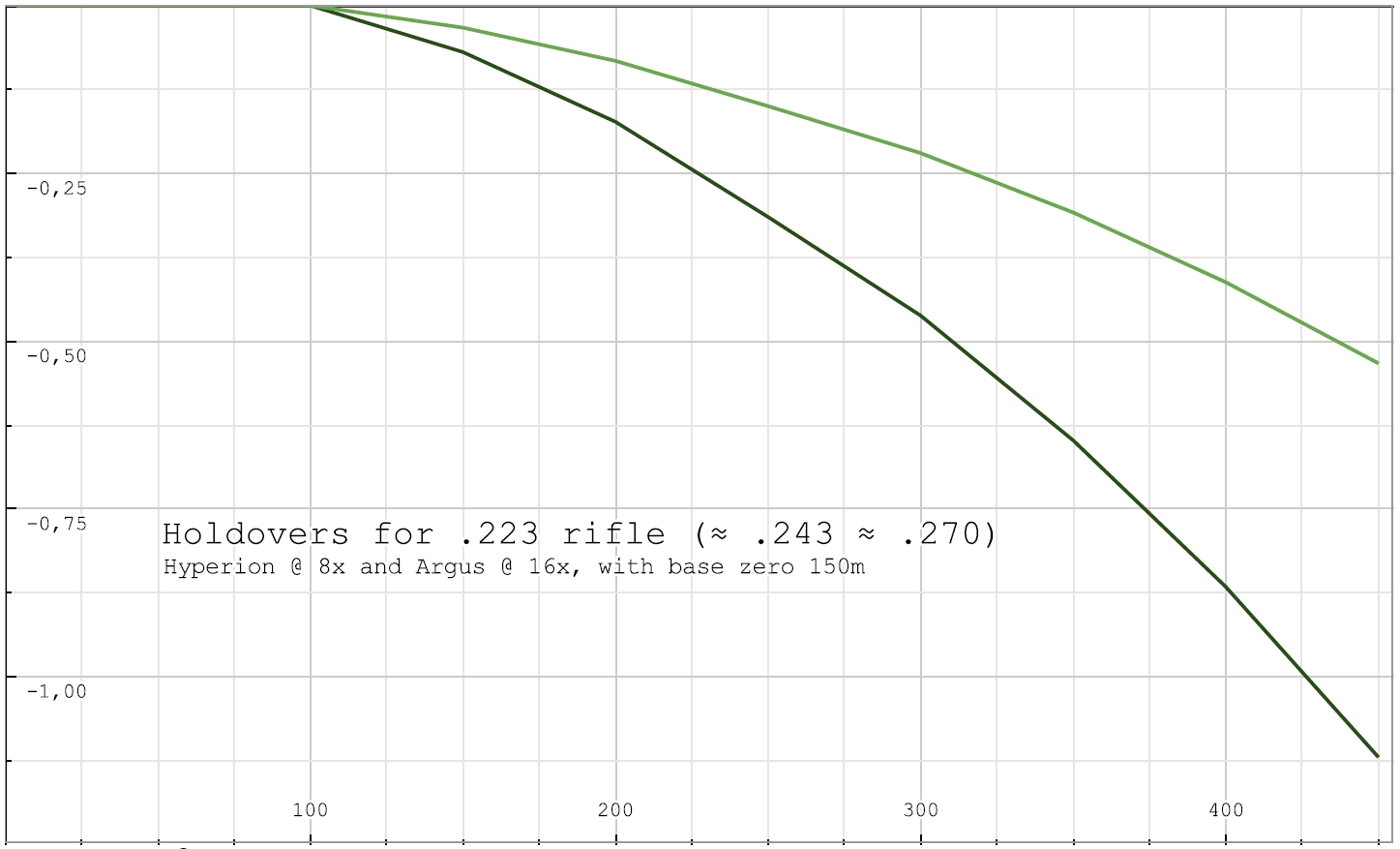
Holdovers for the .223 rifle. This should also work nicely for the .243 and .270 calibers because they have very similar trajectories.
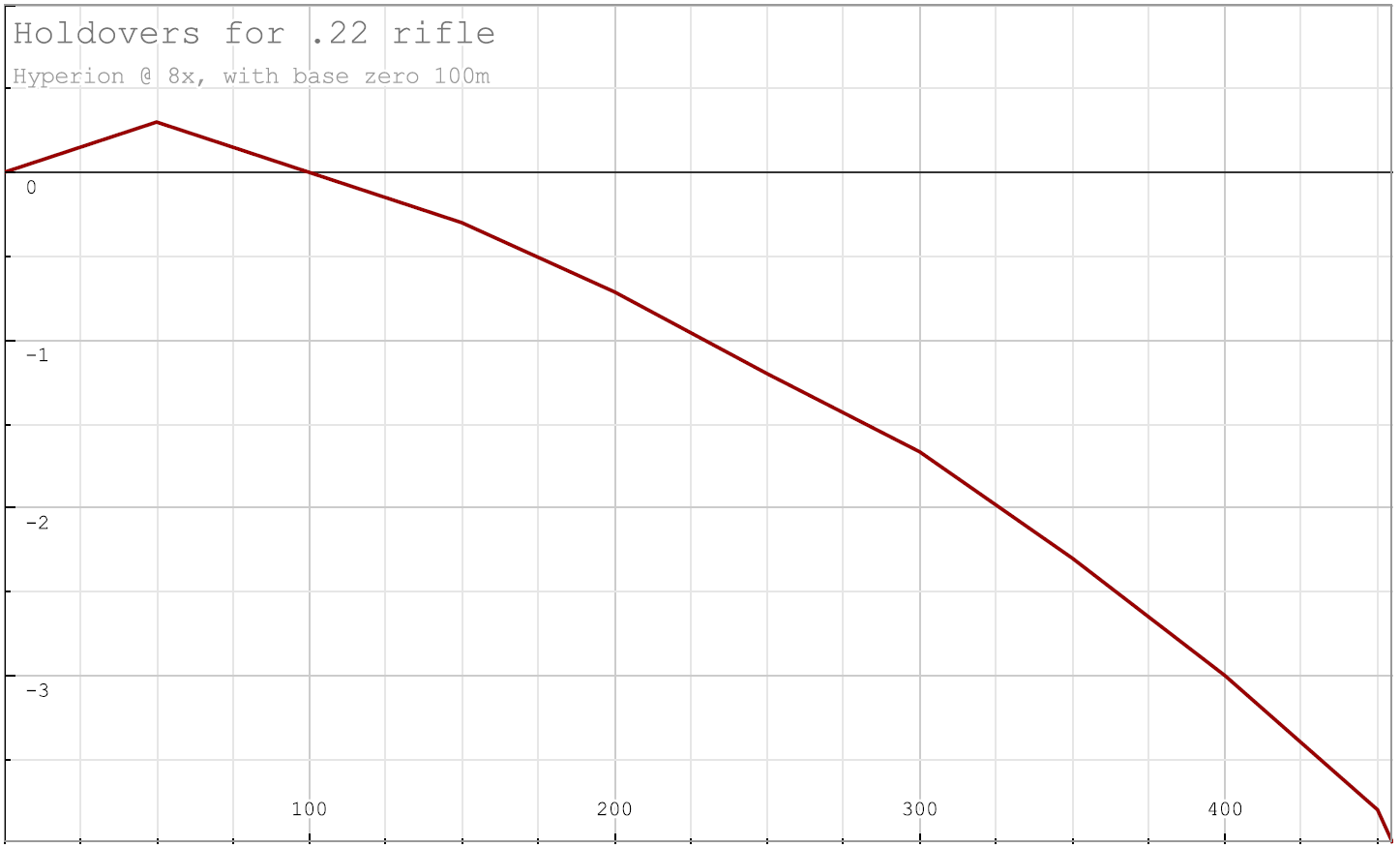
Holdovers for the .22 rifle. Please note that this one only covers the Hyperion riflescope at 8x. If you use the Argus at longer ranges, then the target will be obscured by the thick part of the reticle, in the distorted part of the image. Meanwhile, the max distance for the Hyperion is approx. 455 meters. This is at 4 gaps, where the thin reticle meets the thick post.
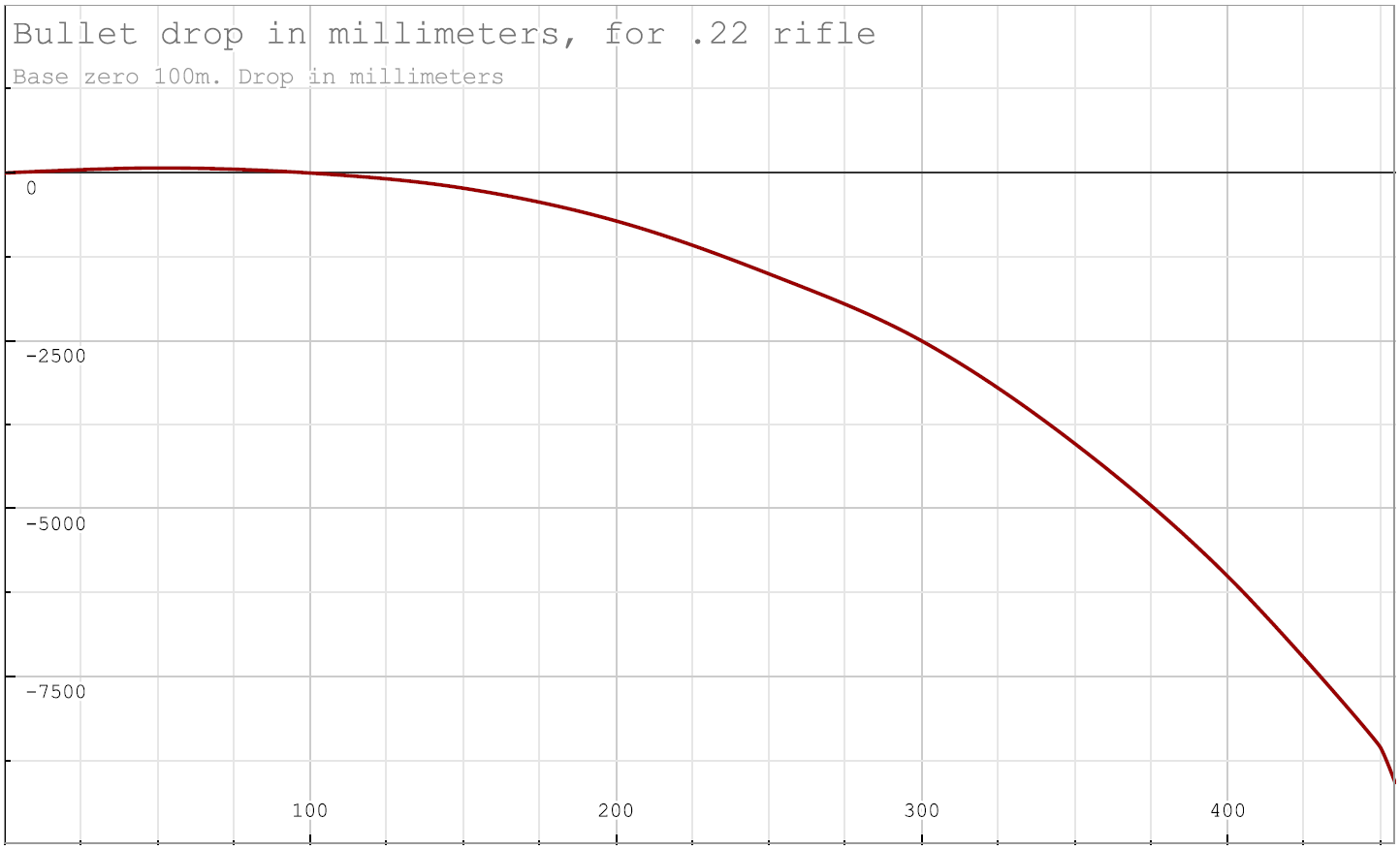
NOT HOLDOVER. This shows bullet drop in millimeters for the .22 rifle. For comparison.
Hope you enjoy the Guide about theHunter: Call of the Wild™ – How to actually use the dots in the reticle of your scope, if you think we should add extra information or forget something, please let us know via comment below, and we will do our best to fix or update as soon as possible!
- All theHunter: Call of the Wild™ Posts List


Hello. Amazing guide by the way. Definitely helps in COTW.
But I was just wondering why you used a “.2” in example 3 (3,2 gaps) instead of a “.5” for the halfway point in between the dots. And how would we estimate, if the target’s shoulders were between the “.2” and the starting mil? As in, not exactly measuring halfway.
Thank you in advance!